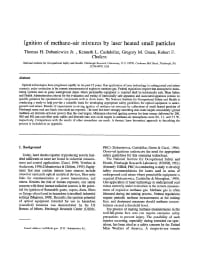Mining Publication: Ignition of Methane-Air Mixtures by Laser Heated Small Particles
Original creation date: May 2000
Authors: TH Dubaniewicz, KL Cashdollar, GM Green, RF Chaiken
NIOSHTIC2 Number: 20022694
J Loss Prev Process Ind 2000 May 13(3-5):349-359
Optical technologies have progressed rapidly in the past 15 years. One application of laser technology in underground coal mines currently under evaluation is the remote measurement of explosive methane gas. Federal regulations require that atmospheric monitoring systems used in gassy underground mines where permissible equipment is required shall be intrinsically safe. Mine Safety and Health Administration criteria for the evaluation and test of intrinsically safe apparatus and associated apparatus contain no specific guidance for optoelectronic components such as diode lasers. The National Institute for Occupational Safety and Health is conducting a study to help provide a scientific basis for developing appropriate safety guidelines for optical equipment in underground coal mines. Results of experiments involving ignition of methane-air mixtures by collections of small heated particles of Pittsburgh seam coal and black iron oxide are reported. The inert but more strongly absorbing iron oxide targets consistently ignited methane-air mixtures at lower powers than the coal targets. Minimum observed igniting powers for laser energy delivered by 200, 400 and 800 um core fiber optic cables and directed onto iron oxide targets in methane-air atmospheres were 0.6, 1.1, and 2.2 W, respectively. Comparisons to results of other researchers are made. A thermal layer theoretical approach to describing the process is included as an appendix.

NIOSHTIC2 Number: 20022694
J Loss Prev Process Ind 2000 May 13(3-5):349-359
- Are lithium-ion cells intrinsically safe?
- Evaluation of Person-Wearable Methane Monitors
- Factors Affecting the Location of Methanometers on Mining Equipment
- Laser Ignition of Flammable Gas
- Lasers
- Methane Emission Rate Studies in a Northern West Virginia Mine
- Methane-Air Mixtures Ignited by CW Laser-Heated Targets on Optical Fiber Tips: Comparison of Targets, Optical Fibers, and Ignition Delays
- NIOSH Research for Monitoring and Controlling Methane at U.S. Underground Coal Mining Operations
- Remote Fiber-Optic Methane Monitor
- Remote Methane Sensors
- Use of a Test Box to Measure Response Times for Machine-Mounted Monitors